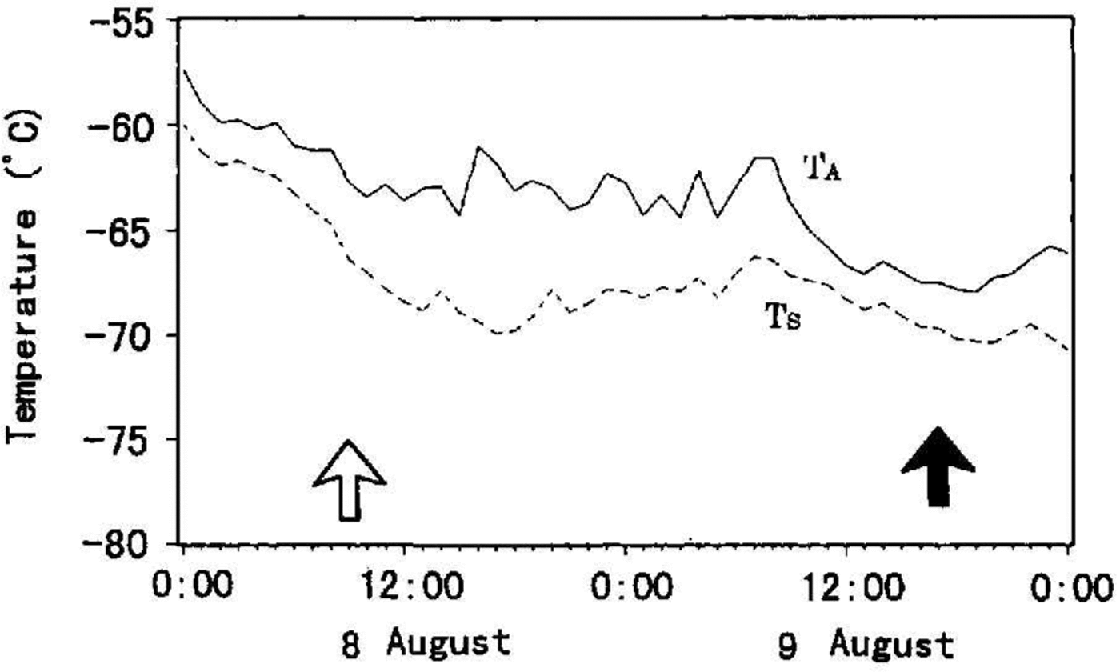The Editor,
Journal of Glaciology
Sir,
Many small balls were observed on the surface of the ice sheet at Dome Fuji station (77°19′01″S, 39°42′12″E; 3810 m a.s.l.), located at the highest point in Dronning Maud Land, Antarctica, during the first overwintering of the Japanese Antarctic Research Expedition (JARE) in 1995. Solid-needle-type (SN) surface hoar crystals formed the balls. Figure 1 shows a cluster of the balls; their diameters range from 5 to 30 mm. They were naturally collected by wind. They look quite similar to globular marimo plants (Cladophora sauteri Kützing; Reference SakaiSakai, 1964) which are observed in Lake Akan in Hokkaido, Japan. Thus, we named them “yukimarimo” (“yuki” means snow in Japanese). They were fragile, but did not break apart when handled carefully. The average density of yukimarimo was about 50 kg m3. The photograph in Figure 1 was taken at 1100 h on 26 October 1995, and that in Figure 2 the day before (0900 h on 25 October) at the same location. SN surface hoar crystals were growing on the snow surface, and some crystals were already formed into lumps of SN surface hoar crystals and yukimarimo, as indicated by arrows. Figure 3 shows the microscopic photograph of the SN surface hoar crystals. The mean diameter and the length of the needle crystals are about 0.01 and 1 mm, respectively. The shape is different from commonly observed “feathery and flat” surface hoar crystals (Reference Lang, Leo. and Brown.Lang and others, 1984; Reference ColbeckColbeck, 1988; Reference ColbeckColbeck and others, 1990), but is similar to “solid needle” snow crystals (Reference Shimizu and MellorShimizu, 1964) which were observed at –50.0°C at Byrd Station, Antarctica.

Fig. 1. “Yukimarimo” on the snow surface at Dome Fuji station, Antarctica.

Fig. 2. SN surface hoar crystals and yukimarimo on the snow surface.

Fig. 3. SN surface hoar crystals.
Similar descriptions of yukimarimo were briefly reported by Reference Amundsen and Chater.Amundsen (1912, p.389) and Reference SipleSiple (1959, p.290). Roald Amundsen observed “cylindrical bodies of drift snow” on the snow surface during his first traverse on the Ross Ice Shelf, Antarctica, in September 1911. He wrote that “Fine, extremely fine, drift-snow collected, and formed small cylindrical bodies of an average diameter of 1 ¼ inches, and about same height; they were, however, of various sizes”. Paul A. Siple wrote that “Some days the Met men saw ‘snow down’, wispy balls of frost one to two inches in diameter, but so delicate that the slightest touch caused them to collapse into nothing”. This observation was made during the first overwintering at Amundsen–Scott station at South Pole in 1957. The descriptions by the two authors correspond well with our observations. However, we could find no other information on this subject in the literature.
Snow surface conditions around Dome Fuji station were examined at least once a day from July to October 1995. We observed yukimarimo and SN surface hoar crystals six times, and the SN surface hoar crystals alone twice. They survived 1–3 days on the snow surface. When the wind was strong, they disappeared.
Air and surface-snow temperature changes during the formation of yukimarimo and SN surface hoar crystals are shown in Figure 4. Air temperature was measured at 1.5 m height (Japan Meteorological Agency, 1996), and surface snow temperature at 0.01m depth (Reference Kameda, Azuma., Furukawa., Ageta. and Takahashi.Kameda and others, 1997b). We did not notice any yukimarimo and SN surface hoar crystals on the snow surface at the time marked by the open arrow, but we observed yukimarimo and SN surface hoar crystals at the moment indicated by the solid arrow. Thus, they were formed during the period between the two arrows. Air temperature during the formation period varied from –60.3° to –68.2°C, and surface snow temperature from –66.3° to –69.8°C. Because the surface snow was cooled by radiation, water vapor in the air near the surface should have condensed and formed SN surface hoar crystals on the snow surface.

Fig. 4. Air and surface, snow temperatures during the formation of yukimarimo, 8–9 August 1995. Yukimarimo and SN surface hoar crystals on the snow surface were not observed at the time marked by the open arrows, but were observed at the moment indicated by the solid arrow.
Table 1 summarizes meteorological conditions during the formation of yukimarimo and SN surface hoar crystals for all observations in 1995: air temperature (T A), surface snow temperature (T S) and wind velocity (V). Maximum and minimum values during the formation period are shown in T A, T S and V. Wind velocity was measured at 2.2 m height (Reference KamedaKameda and others, 1997a). The average thickness of SN surface hoar crystals at the end of the formation period was measured on the snow surface, and at 0.8 and 1.3 m above the snow surface on two bamboo poles.
Table 1. Meteorological conditions when yukimarimo and SN surface hoar crystals were observed at Dome Fuji station in 1995

Yukimarimo and the SN surface hoar crystals were observed when air temperature ranged from –38.2° to –79.6°C, surface snow temperature from –40.6° to –80.9°C and wind velocity from 0.5 to 11.7 m s−1. Yukimarimo was found when maximum wind velocity was >3.0 m s−1. Thick layers of SN surface hoar crystals were observed on 9 August, 11 September and 27 September when air temperature ranged from –59.3° to –71.9°C, surface snow temperature from –64.1° to –71.6°C and wind velocity from 0.5 to 4.2 m s1. It seems that these values delimit the most favorable conditions for the growth of SN surface hoar crystals.
If the thickness of the SN surface hoar crystal layer was growing at a constant rate during the formation period in Table 1, the thickness growth rate ranged from 0.08 to 0.3 mm h1 at the snow surface. The smallest rate was observed when the surface snow temperatures were lower (19 and 24 August, 22 September) or higher (25 October) than those delimiting the most favorable conditions.
We conclude that air temperature from –59.3° to –71.9°C, surface snow temperature from –64.1° to –71.6°C and wind velocity from 0.5 to 4.2 m s−1 are the most favorable conditions for the growth of SN surface hoar crystals on the snow surface. In addition, when wind velocity is >3.0 m s1, some of the SN surface hoar crystals will rotate on the snow surface and form yukimarimo.
Acknowledgements
We would like to express our sincere thanks to JARE-36 members. E. Akitaya, M. Hachikubo and I. Wakana kindly referred us to some of the literature cited in this letter. The authors are indebted to S. Takahashi for valuable discussions. Comments from an anonymous reviewer are gratefully acknowledged. This letter is a contribution from the “Deep Ice Coring Project at Dome Fuji Station, East Antarctica” (principal investigator: O. Watanabe).







